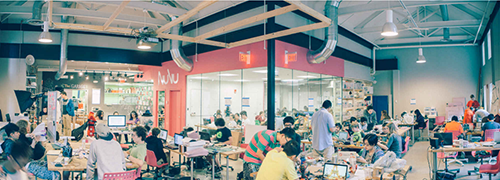Video: NuVu Studio Breaks the “Classroom” Model
-
-
slice.mit.edu
- 4
Filed Under
NuVu Studio in Cambridge—founded in 2010 by Saeed Arida SM ’04, PhD ’11; David Wang ’05, SM ’10, PhD ’15; and Saba Ghole SM ’07—aims to break the mold of contemporary education and foster creativity above all else for school-age children.
“When we go to traditional schools, things feel frozen in time,” says Arida, NuVU chief excitement officer. “The minute people come in the door, it becomes really clear to them how different this environment is from their traditional environment.”
Instead of courses, NuVu has studios where 12 students, aged 11-18, work with two coaches on solving open-ended problems. Rather than learning separate and segmented subjects, students move between a studio that requires them to design a robot to another that requires them to re-imagine Boston with a cable car system.

They’ve enrolled over 3,000 students over six years from around the world. Their reputation spread through word-of-mouth and coverage from NPR. As a result, they’ve formed partnerships with public, private, charter, and international schools that allow students to enroll full-time at the studio for a semester or trimester.
NuVu also enrolls long-term students who spend one to four years full-time at NuVu completing their middle or high school years.
“We really do teach creativity, and we let all the other skills fall in line behind it,” says Wang, NuVu chief technology officer.
Upon entering the studio, you immediately notice there are no classrooms nor a schedule that divides each class into one-hour intervals. Students are given a prompt, and they spend two weeks from 9:00 a.m.–3:00 p.m. solving that problem in an open space before presenting their final product to their peers.
“When students are actually applying and experiencing and learning by doing, that has a greater impact on how students are processing that information,” says Ghole, NuVu chief creative officer. “We see it day in and day out.
Not only is the studio changing the learning experience for students, but they’ve also changed how educators approach teaching. Every summer, teachers are invited from other schools to experience their learning model.
“We’ve had many teachers come from around the world, and the first question they have once they see what the place is all about is, ‘How can we bring this type of work back to our schools,’” says Ghole.
The teachers undergo a similar process as the students. They develop an idea, the coaches at NuVu will critique it and help evolve it, and they work together to build a project for students to complete. Essentially, the teachers become students immersed in a world of wonder.
The NuVu co-founders envision the future of education as incorporating more hands-on learning with an emphasis on fostering individual creativity. Through charging students a tuition, they can afford the equipment necessary to establish an atmosphere of innovation.
“We want to motivate students, to let them see that they can have an impact,” says Wang. “Everything they learn, they can use to improve themselves and the world around them.”
To Ghole, this vision came from their shared experience at MIT.
“Learning by doing is a really important motto,” says Ghole. “MIT’s model is ingrained in that philosophy. A lot of my pivotal educational moments have been focused around experiences where I got to create things.”
However, Arida says, as important as reshaping education is for NuVu, the students always come first.
“What makes it worthwhile for us at the end of the day is seeing the impact something like this has on the students.”








Comments
Gary Porfert
Sat, 09/17/2016 3:42pm
It's great to see innovative approaches to improving education. But NuVu appears to have a student to teacher (coach) ratio of 6:1. In the middle school where my wife teaches, it's more like 30:1 when you just look at front-line teachers, although there are also many, many people in 'support' positions who do not actually teach in a classroom on a daily basis. Any realistic approach to improving educational outcomes has to address that as well as the obvious 'selectivity' issue.
Keshav Gupta
Sat, 09/10/2016 6:55am
Great way to teach & learn!
Emil Friedman
Thu, 09/08/2016 12:54pm
Will this work for the majority of students or just for a select few? (Imagine MIT enrolling its freshman class by random selection from all high school students.)
What about students who are interested in math and science but not history or vice-versa?
Hector Arana
Sun, 08/20/2017 6:16pm
Hi! We are a family in Mexico City (parents + 1 daughter-14 years, + 1 daughter-11 years, + 1 son-7 years, + 1 son-5 years), very interested in international programs to encourage the potential. My daughters and sons study in Swiss College of Mexico, some of them speak 4 languages (the smallers just german and spanish). Sofía (the oldest one) dreams about studying at MIT. I would like to make contact with NuVu programs and people that cans help us.
Hector Arana